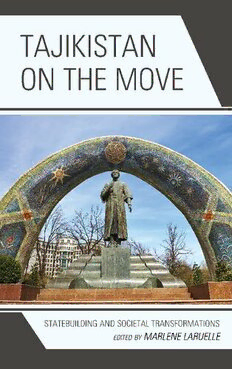
Tajikistan on the Move: Statebuilding and Societal Transformations PDF
Preview Tajikistan on the Move: Statebuilding and Societal Transformations
Tajikistan on the Move CONTEMPORARY CENTRAL ASIA: SOCIETIES, POLITICS, AND CULTURES Series Editor Marlene Laruelle, George Washington University At the crossroads of Russia, China, and the Islamic world, Central Asia re- mains one of the world’s least-understood regions, despite being a significant theater for muscle-flexing by the great powers and regional players. This series, in conjunction with George Washington University’s Central Asia Program, offers insight into Central Asia by providing readers unique access to state-of-the-art knowledge on the region. Going beyond the media clichés, the series inscribes the study of Central Asia into the social sciences and hopes to fill the dearth of works on the region for both scholarly knowledge and undergraduate and graduate student education. Recent Titles in Series Eurasia’s Shifting Geopolitical Tectonic Plates: Global Perspective, Local Theaters, by Alexandros Petersen The New Geopolitics of the South Caucasus: Prospects for Regional Coop- eration and Conflict Resolution, edited by Shireen T. Hunter Constructing the Uzbek State: Narratives of Post-Soviet Years, edited by Marlene Laruelle Language, Literacy, and Social Change in Mongolia: Traditionalist, Social- ist, and Post-Socialist Identities, by Phillip P. Marzluf The Dialectics of Post-Soviet Modernity and the Changing Contours of Islamic Discourse in Azerbaijan: Towards a Resacralization of Public Space, by Murad Ismayilov The European Union’s Influence in Central Asia: Geopolitical Challenges and Responses, by Olga Alinda Spaiser Central Asia in the Era of Sovereignty: The Return of Tamerlane?, edited by Daniel L. Burghart and Theresa Sabonis-Helf State-Building in Kazakhstan: Continuity and Transformation of Informal Institutions, by Dina Sharipova Tajikistan on the Move: Statebuilding and Societal Transformations, edited by Marlene Laruelle Tajikistan on the Move Statebuilding and Societal Transformations Edited by Marlene Laruelle LEXINGTON BOOKS Lanham • Boulder • New York • London Contents List of Figures vii List of Tables ix Acronyms xi Political Map of Tajikistan xiii Introduction xv Marlene Laruelle PART I: S TATE DYNAMICS, POLITICS, THEIR ACTORS, AND THEIR SPACES 1 Hobbesian Neopatrimonialism 3 Jesse Driscoll 2 Rebels without a Cause? Authoritarian Conflict Management in Tajikistan, 2008–2015 33 John Heathershaw and Parviz Mullojonov 3 From Moscow to Madrid: Governing Security Threats beyond Tajikistan’s Borders 63 Edward Lemon 4 Tajikistan’s Multi-Vector Foreign Policy: Constructing Relations with Russia, China, and the United States 87 Kirill Nourzhanov v vi Contents PART II: T AJIK SOCIETY: LOCAL DEVELOPMENTS AND SOCIAL VULNERABILITIES 5 Dushanbe Is Quite Far: Deconcentrated Agrarian Reform in Rural Tajikistan 111 Brent Hierman 6 Local Governance in Khatlon, Tajikistan 131 Suzanne Levi-Sanchez 7 Development Practices, Insecurity, and Risks: Injectable Drug Users in Gorno-Badakhshan 149 Sophie Hohmann 8 “A Woman without a Man is a Kazan without a Lid”: Polygyny in Tajikistan 171 Michele E. Commercio PART III: STATE MEMORY AND MOVING IDENTITIES 9 Oblivion, Ambivalence, and Historical Erasure: Remembering the Civil War in Tajikistan 195 Tim Epkenhans 10 Translocal Securityscapes of Tajik Labor Migrants and the Families and Communities They Leave Behind 223 Hafiz Boboyorov 11 Illegal Migrants and Pious Muslims: The Paradox of Bazaar Workers from Tajikistan 247 Sophie Roche Bibliography 279 Index 301 About the Editor and Contributors 309 List of Figures Figure 0.1. Political Map of Tajikistan (2001) xiii Figure 5.1. Changes to Area Devoted to Cotton Production and the Price of Cotton Since Independence 113 Figure 5.2. Change in Agricultural Exports Over Time 114 Figure 5.3. Simplified Model of Land Reform Policy Implementation Process 116 Figure 5.4. Farm Individualization by District and Region 118 Figure 5.5. Agricultural Production by Farm Type 121 Figure 5.6. Male-Headed Dehqan Farms and Female-Headed Dehqan Farms Compared 124 Figure 9.1. Special Issue Stamps by the Tajik Post Office Commemorating the 65th Anniversary of Victory Day in 2010 196 Figure 11.1. Tajik Porter Taking a Rest 257 Figure 11.2. Uzbek Porter from Tajikistan with a Load 262 Figure 11.3. Hierarchy of the Bazaar from a Migrant’s Perspective 266 Figure 11.4. Tajik Vendors at the Bazaar 269 vii List of Tables Table 2.1. Minor Armed Conflicts Concerning Tajikistan, 1995–2015 34 Table 2.2. Variables and Modes of Authoritarian Conflict Management: Multi-Pyramid Order (“War-Time Political Orders” [Staniland]) 41 Table 2.3. Variables and Modes of Authoritarian Conflict Management: Single-Pyramid Order (“Protection Pact” [Slater]) 41 Table 2.4. Tajikistan’s Minor Armed Conflicts in Terms of ACM, 1995–2015: Multi-Pyramid Order 52 Table 2.5. Tajikistan’s Minor Armed Conflicts in Terms of ACM, 1995–2015: Single-Pyramid Pact 53 Table 3.1. List of Cases 79 Table 4.1. Intertextual Research Model of Foreign Policy Analysis 90 Table 4.2. “Should Tajikistan have better relations with these countries; more distant; or the same as now?” (2016 poll, percent, respondents aged 14–29) 101 Table 6.1. Ethnic, Sub-Ethnic, and Sub-Sub-Ethnic Groups in Qurghonteppa 143 Table 6.2. Words for Kinship Relationship. 144 Table 8.1. Labor Force Participation Rate (Percent of Male/ Female Population Ages 15+) 176 ix
